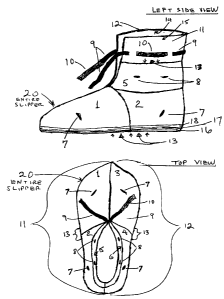Note: Claims are shown in the official language in which they were submitted.
6
Claims:
The embodiments of the invention in which an exclusive property or privilege
is claimed are
defined as follows:
1. A therapeutic slipper that contains a natural grain that is heated or
cooled to provide warmth or cold
to the feet and toes of the wearer.
2. The therapeutic slipper, as defined in claim 1, described a slipper, heated
or cooled to provide
warmth or cold that contains a natural grain product that retains heat or cold
when placid is a
microwave or freezer respectively, for a specific period of time. Grains have
excellent heat/cold
retention properties.
3. The therapeutic slipper, as defined in claim 2, described the heat/cold
retention qualities of grains of
which there are different kinds, some having better heatlcold retention
qualities than others. Some
people are allergic to certain grains. The use of other grains will enable
these people to benefit from
the slipper. Some grains that are used are wheat, oat or flax seed.
4. The therapeutic slipper, as defined in claim 1, described a slipper, heated
or cooled to provide
warmth or cold, is made up of compartments containing the grain and the
compartments are located
between the liner and the facing material, sewn together. Several compartments
make up a slipper
and the number of them is dependant on the size and style of the slipper.
5. The therapeutic slipper, as defined in claim 4, described the compartments
and the compartments
cover the entire area of the foot and lower leg, providing uniform, consistent
heat or cold to
specific, sensitive areas of the foot. Different styles of slipper can cover
more of the leg.
6. The therapeutic slipper, as defined in claim 4, described the compartments
and the compartments
stop the grain from shifting from one end of the slipper to the other thereby
enabling providing
consistent heat or cold.
7. The therapeutic skipper, as defined in claim 4, described the compartments
and the compartments
provide structure, form, support and firmness to the slipper making the sides
of the slipper more
upright. Without the compartments, the grain would settle to the bottom and
the slipper would not
be effective.
8. The therapeutic slipper, as defined in claim 4, described the compartments
and the compartments
contain short, support stitches sewn into certain locations in the compartment
to give further
7
structure and uprightness to the sides of the slipper while allowing the grain
to move freely. The
compartments are sewn into different areas of the slipper depending on the
size and style of slipper.
9. The therapeutic slipper, as defined in claim 8, described the compartments
containing support
stitches. Different styles of slippers have additional compartments locate
above and adjacent to the
lower compartments to provide further heat or cold to the upper foot and lower
leg.
10. The therapeutic slipper, as defined in claim 8, described the compartments
and support stitches. The
amount of grain required in each compartment varies depending on the size and
style, but the
compartments are packed tight with grain. The grain is distributed evenly in
the slipper to ensure the
entire foot is heated or cooled in a consistent, uniform fashion. The grain is
absorbed and retained in
the grain. There is a proper balance between the quantity of grain far
heat/cold retention purposes
and the weight of the slipper on the foot. The slipper is lightweight and does
not become
uncomfortable to the wearer or cause the slipper to sag.
11. The therapeutic slipper, as defined in claim 1, described the compartments
containing grain. The
grain shifts and expands in the compartments to form around the contours of
the foot
accommodating a variety of foot shapes and sizes and allowing for some
swelling of the feet
12. The therapeutic slipper, as defined in claim 1, described a slipper that
is heated or cooled to provide
warmth or cold to the feet and toes has a fastener that holds the slipper
around the ankle or lower
leg to ensure that the slipper is kept snug around the foot and to prevent the
slipper from sagging.
Different fastening methods and materials are used such as a drawstring or
n'bbon that is fastened
like a shoelace or a drawstring with an easy to fasten Velcro end. A Velcro
flap adds to further
simplifying the task of fastening the slipper, especially for the elderly
people or thone with muscle
problems.
13. The therapeutic slipper, as defined in claim 1, described a slipper that
is heated or cooled to provide
warmth or cold to the fit and toes. The lining, facing material, sole and
fastener are made of
different types of material such as cloth fabrics, mesh fabrics or leather.
The cloth fabric can be
cotton, soft flannel, chamois, imitation fur material, felt or fleece. Leather
and canvas material are
lightweight, strong yet supple and are good breathers. The lining, facing
material, sole and fastener
14. The therapeutic slipper, as defined in claim 13, described the different
material used for the slipper
and the sole of the slipper is made of a material that prevents slipping on
hardwood or tile doors and
8
yet allows some sliding of the foot on the floor to prevent tripping. This is
particularly beneficial for
the elderly or those with walking problems.
